By Jeffrey A. Rendall, Photos By Jeff Janas
WILLIAMSBURG, VA -- Only in America would a King end up building a Plantation in Virginia. No, I'm not talking about King George III and Mount Vernon. That particular King and that particular Plantation probably wouldn't have gelled very well. But when it comes to golf -- Arnold Palmer, 'The King' -- and Kingsmill Resort, once a Colonial era Plantation, combined together like two peas in a pod. The winners in this not-so-odd partnership are the golfers who play the result of their collaboration -- the Plantation golf course.
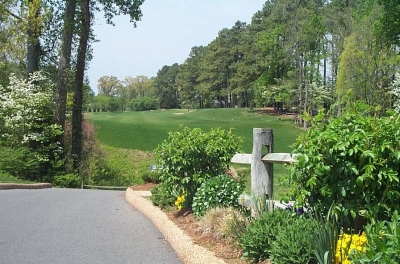 |
| The Plantation Course's 1st tee is very proximate to the River Course, yet there's quite a difference in the rest of the two courses. |
The Plantation course shares its clubhouse and practice facilities with the more famous Kingsmill River Course, site of the LPGA's Michelob Light Championship (in May) -- and kicks off from a first tee only a stone's throw away from the River's 10th tee and 18th green. But despite the topographical similarities and common resort amenities, the two courses play very differently. The Pete Dye designed River course is much more difficult, mainly because there's a lot less room to miss.
In contrast, the Plantation course features extremely generous fairways, relatively tame yardage figures and large greens. Chances are, you'll spend a lot less time looking for the ball and tossing clubs in frustration on the Palmer course. But don't let the numbers lead you astray -- Arnie didn't just plot out a tulip bed for the average resort guest to tiptoe through with nary a sweat bead on their brow.
He'll get you on the greens. The Plantation's reputation stems from its severely undulating, tiered greens. So even if you'll take out a shorter club to attack the big putting surfaces -- you'd better be able to place the ball in the vicinity of the flag, or suffer the consequences.
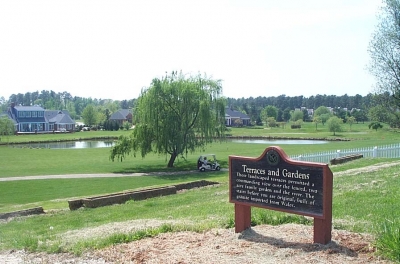 |
| Interpretive signage is found throughout Kingsmill's property -- a tangible link to the past. |
Summer Lee, Head Golf Professional at Kingsmill, describes the challenge to perfection: "The Plantation course, being a Palmer design, means you've got real big, undulating greens. They're forgiving to get to -- but once you get on 'em, that's where the difficulty lies."
"You'll notice when you look at the yardage figures that the course really isn't all that long, and once you're out there you'll see it's pretty wide. There's a lot of room to miss, and that makes the Plantation a popular choice for ladies, seniors and your higher handicappers. But it's not an 'easy' course either, because of the severity of the greens," Lee said.
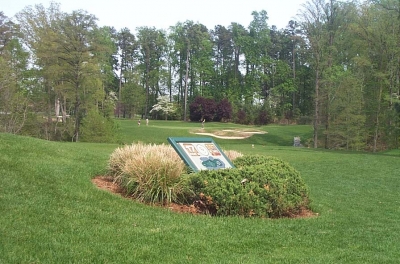 |
| You can't really see it here, but there's a large ravine between the tees and green on the par three 17th hole. |
She continues, "For that reason, it's a very enjoyable course for all levels of participants. Even the best players will have a solid test of their short games to score well."
And although the River and Plantation courses play quite differently, both contain the same link to history that's so evident throughout the Kingsmill Resort Property. You won't find the high numbers of archeological site markers that the Kingsmill Woods Course offers, but the sheer size of the Plantation's main historical draw makes up for it.
Along the right side of the second hole is the original location of Kingsmill Plantation's grand manor house and outbuildings -- home to four generations of one of Virginia's oldest families, the Burwells. Golfers playing the back sets of tees who tend to hit a high slice could very well come face to face with the past -- I should know. I can't recall hitting too many other shots just a few yards away from a 250 year old set of granite stairs (the manor house burned in 1844, but the foundation still exists, along with the large granite staircase that once led up to the mansion). Just one of the many unique experiences Kingsmill and the Plantation Course offers.
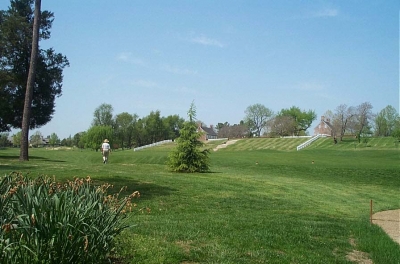 |
| The right side of the par five 2nd hole is where Kingsmill Plantation's grand manor house and outbuildings once stood. |
The course then meanders in and out of peaceful residential areas, and reminded me somewhat of Hilton Head golf in 'feel.' One nice thing about the Plantation Course -- although it's not nearly as isolated and serene as say, the Woods Course -- the houses are well set back from the fairways, and there's often a good sized tree buffer to enhance the quality of the experience for the golfer, as well as protect the homes from dimpled ball bombardment. You can even see Curtis Strange's house from one of the greens (as was pointed out by my playing partners, Dave Gurkin and his neighbor Ed).
It's a well thought out resort course, and very characteristic of many of the better golf communities these days.
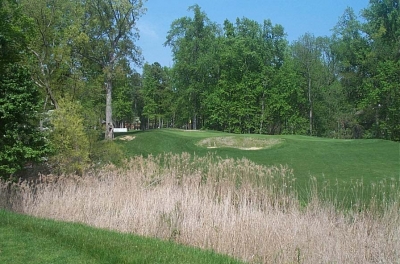 |
| Yardage figures may disguise the difficulty you'll find on the Plantation Course. There are a few carries and tough greens. |
Turning to the course, I'll try and highlight a few holes that were my favorites. I will note there's a significant jump in challenge from the blue tees to the whites on certain holes on the course, and that's never more apparent than on the first and second tees, where the back sets present forced carries, and the forward tees are granted about a hundred yard head start across the ravines. The gold and blue sets play to 6543 and 6092, respectively, and the white and red sets are at 5503 and 4880.
The second hole is a nice reachable par five at 503 yards from the back, playing to a slight dogleg right. As mentioned above, the tee shot must carry a ravine that really shouldn't be a factor if you get any air under the ball, and along the right side are the aforementioned Kingsmill Plantation grounds. Second shots, if you're in position to go at the green in two, must navigate a well-bunkered green to give yourself an eagle putt. There's very little room to run it up, so you'll have to hit two pretty solid high metal woods to reach the putting surface.
The fourth hole is the Plantation's number one handicap hole. The tee shot favors a draw, with the left-hand side protected by a lake and trees. Placement of the drive is critical to have a good angle to shoot at the huge undulating green with three tiers -- and is protected by the lake on the left and two large bunkers to the right. Even if you manage to hit the green in regulation, it's certainly no gimme par if you're not on the right level.
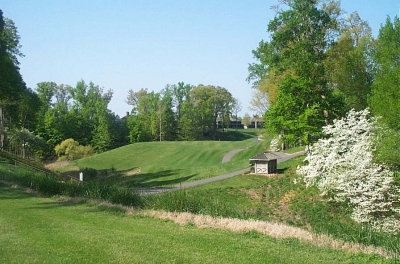 |
| Don't go right off the tee on the second hole, or you might find yourself in the manor house's front yard. |
Nine is a great short par three, playing 126 yards over a ravine to a severely sloped green protected by bunkers short left and long. If you manage to stay out of the bunkers, you still may face an awkward chip from the sloped first cut around the green. It's not hard at all to make five if you don't get the ball close on your tee shot.
Ten and Eleven are long par fours at 419 and 436 yards -- both guarded adequately by trouble on the right sides of both holes. On the tenth, it's a lake that runs the length of the second shot and guards the green to the right. The eleventh features a deep ravine that runs the entire length of the hole on the right. Slicers take note.
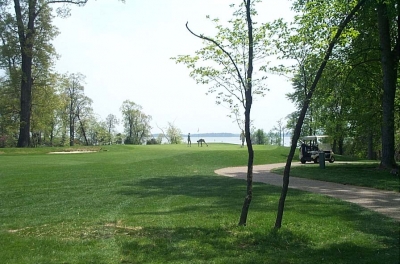 |
| Finishing up on the 18th hole, you'll glimpse the James River. |
Twelve is a short par five, 481 yards from the back. Tee balls must fly a small ravine and finish up precariously close to a bunker on the right side of the fairway to give you a clear chance at going at the green in two. Second shots must carry another ravine, but there's plenty of room for a run-up if you choose that route. Take the right clubs, and par or better is certainly within reach.
Seventeen would compete with #2 for signature hole honors. It's a 177 yard par three, with an amphitheater green perched on what looks like a ledge from the tee, with a steep ravine determining whether you'll have heartache or glory. Not a tremendously difficult hole, but visually pleasing to the eye and three is a good score.
After finishing up on eighteen, you'll take a nice cart path ride alongside the famous eighteenth on the River Course to reach the clubhouse. You'll certainly note that the significant visual intimidation on the River's finishing hole is a far cry from what you've just seen on the Plantation Course. But that's okay -- the two courses are meant to be different. And perhaps after being crushed by the River Course, the Plantation's 'difference' may be very welcome indeed. That's just how the King would want it.
Details:
The Plantation Course At Kingsmill Resort
1010 Kingsmill Road
Williamsburg, VA 23185
Phone: (757) 253-3906
Toll Free: (800) 832-5665
Website: www.kingsmill.com
Course Designers: Arnold Palmer & Ed Seay
Head Golf Professional: Chris Hartig (Summer Lee is now at Richmond's Country Club of Virginia).
Director of Golf: Wayne Nooe
| Tees | Yardage/Slope | Rating |
| Gold | 6543/119 | 71.6 |
| Blue | 6092/114 | 69.3 |
| White | 5503/107 | 66.5 |
| Red | 4880/116 | 69.0 |
Rates:
Rates vary -- Contact the resort for individual course rates and package rates.
| Related Links | Comments on this article? | |
|
Maryland National Golf Club Hollow Creek Golf Club Rocky Gap Resort PB Dye Golf Club in Ijamsville Whiskey Creek Golf Club |
E-mail Jeff Rendall, Editor: jrendall@golftheunitedstates.com |












